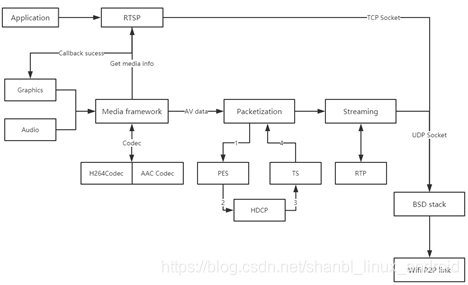 版权声明:署名,允许他人基于本文进行创作,且必须基于与原先许可协议相同的许可协议分发本文 (Creative Commons)
版权声明:署名,允许他人基于本文进行创作,且必须基于与原先许可协议相同的许可协议分发本文 (Creative Commons)
之前写的miracast技术分享,公司非要用英文。搞了好几天,现在想翻译也是有心无力。就当展示一下英文水准了
1. Introduction
Mircast is called wifidisplay, a mechanism to discover, pair, connect and render multimedia content sourced from a Wi-Fi Display Source at a Wi-Fi Display Sink.

Source: the device which is captured media data from, phone usually used as source.
Primary sink: The device play the captured media data, TV usually used as primary sink.
Sencondary sink: The sencondary device play the captured media data, voice box usually used as sencondary sink.
2. Architecture
The constructure of miracast is complex, so much module is used for supporting miracast working. see architecture below:

2.1. Explain
Wifi-P2P: Wifi direct technology which is specified by wifi alliance. used for setup L2 link
TDLS: A new technology which is specified by wifi-alliance, used for setup L2 link.
IP: IPv4 or IPv6 is allowed
TCP: Transport protocal
RTSP/RTP: Streaming media protocal used for control/transfer media link.
MPEG2-TS: Format of media package, less than 188 Byte.
HDCP: Encryption protocal used for proctect media data in air.
PES: Basic media format.
UIBC: A protocal for controll back, which is used for sink control source behaviour back.
I2C: Bus
2.2. Software Architecture
The implementation of Source can be decomposed below:

The implementation of sink can be decomposed below:

2.3. RTSP/RTP introduction
RTSP is a control proctocal which is usually used for RTP streaming protocal.
RTSP exchange the neccessary info between source and link.
The rtsp connection is set up after the exchange finished below:

M1-request: Source ask the supported options from sink.
M1-response: Sink reply the supported options.
M2-request: Sink ask the supported options from source.
M2-response: Source reply the supported options.
M3-request: Source trying to get the interested media configuration from sink
M3-response: Sink reply its own configuration to source.
M4-reuqest: Source send the suitable media configuration which is compatible between source and sink
M4-reply: Sink reply the result to source.
2.4. UIBC introduction
UIBC is a function for control back, link sink can delivery its touch event to source and source reply it. This function is not popular between phone and TV but it may be useful between phone and car-navi.

Like above, UIBC support so much kind of touch event. can be conclued as HID and generic.
2.4.1. Software implementation
The implementation can be refer to the architecture below:

2.5 RTP
A WFD Source shall encapsulate the MPEG2-TS frames in RTP packets following the guidelines on the encapsulation of MPEG systems multiplex streams over RTP. In particular, MPEG2-TS streams shall be encapsulated in RTP packets as in section 2 of RFC 2250 [4]. The RTP packet length shall be chosen such that the length of the RTP packet plus the length of the UDP and IP headers is less than or equal to the MTU size. As shown in Figure 30 and Figure 31, the RTP payload carries an integral number of MPEG2-TS packets, computed by dividing RTP payload length by the length of an MPEG2-TS packet and rounding the result down. A maximum of 7 MPEG2-TS frames shall be encapsulated in a single RTP packet.
Each RTP packet shall contain a timestamp derived from the sender’s 90 kHz clock reference synchronized to the system stream PCR (MPEG2-TS), and represents the target transmission time of the first byte of the packet payload. This RTP timestamp is not passed to the decoder, and is solely used to estimate and reduce network induced jitter and synchronize relative time drift between RTP transmitter and receiver.

2.6. HDCP
In an HDCP system, two or more HDCP Devices are interconnected through an HDCP-protected interface. The Audiovisual Content flows from the upstream content control function into the HDCP System at the most upstream HDCP transmiter. From there the audiovisual Content encrypted by the HDCP System, referred to as HDCP Content, flows through a tree-shaped topology of HDCP Receivers over HDCP-proctected Interfaces. This specification describes a content procection mechanism for authentication of HDCP receivers to their immediate upstream connection, revocation of HDCP Receivers that are determined by the Digital Content Protection, LLC.

3. WFD usage in android
Only WFD source implemented in android platform. Mostly, it's supported in current deivce and indication in settings.
Most vendor has their own implementation for both source and sink, such as: mtk, qcom, samsung etc.